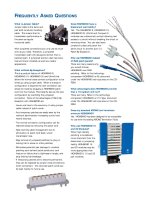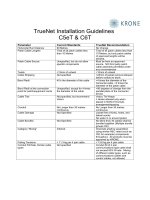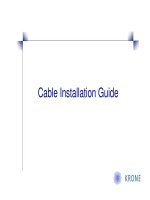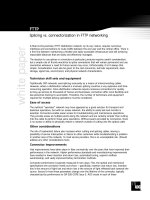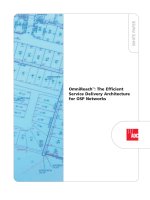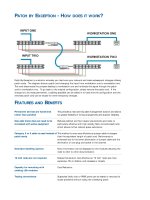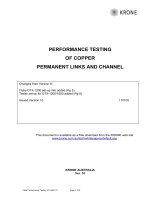ADC KRONE - Guide Book - FTTP - Splicing vs. connectorization in FTTP networking
Bạn đang xem bản rút gọn của tài liệu. Xem và tải ngay bản đầy đủ của tài liệu tại đây (37.15 KB, 4 trang )
white paper
FTTP
A fiber-to-the-premises (FTTP) distribution network, by its very nature, requires numerous
interfaces and connections to route traffic between the end user and the central office. There is
a fine line between maintaining a flexible and easily-accessible infrastructure and still achieving
reasonable distances that are easily and effectively managed.
The decision to use splices or connectors at particular junctures requires careful consideration,
but a simple rule of thumb would be to splice connections that will remain permanent and use
connectors wherever a need for future access may occur. Unfortunately, it isn’t always that
simple. Consideration must also be given to the cost economics, skill sets requirement, slack
storage, signal loss, environment, and physical network characteristics.
Technician skill sets and equipment
Traditionally OSP networks used splicing exclusively as a means of interconnecting cables.
However, where a distribution network is involved, splicing could be a very expensive and time-
consuming operation. Since distribution networks require numerous connections for quickly
turning up services to thousands of homes and businesses, connectors offer more flexibility and
less personnel training to accomplish. Therefore, the number of technicians and equipment
required for multiple splicing operations must be considered.
Ease of access
The mythical “seamless” network may have appeared as a good solution for transport and
backhaul operations, but with an access network, the ability to easily test and monitor is
essential. Connectors enable easier access for troubleshooting and maintenance operations.
They provide access at multiple points along the network and are certainly simpler than cutting
into the cable to perform these same operations. Without seams provided by connectors, there
is no access or ability to physically restore a network outside of cutting into the optical cable.
Other considerations
The risk of inadvertent failure also increases when cutting and splicing cables, leaving a
possibility of service interruption or failure to other customers while troubleshooting a problem
in another area of the network. To most service providers, this is an unacceptable risk. (Should
address any other considerations here)
Connector improvements
Vast improvements have taken place in fiber connectivity over the years that have improved their
performance in the network. Higher performance standards and manufacturing improvements
have resulted in lower insertion and return loss, automated tuning, superior endface
workmanship, and vastly improved factory termination methods.
Connector performance is typically measured in two ways. First, the optical and mechanical
specifications the connector meets out-of-box – specifically, insertion and return loss. Insertion
loss is the amount of light lost and return loss is the amount of light reflected back towards the
source. Second is how these parameters change over the lifetime of the connector, typically
characterized by performance to GR-326-CORE Issue 3. ADC excels in each of these
Splicing vs. connectorization in FTTP networking
2
measurements by offering industry-leading optical and mechanical specifications, backed by
independent third-party test data.
• Better core alignment process – ADC has chosen an automated process rather than a manual
process, relying less on human intervention, giving more accurate and consistent core locations, and
dramatically reducing the potential for damage to the endface. While some manufacturers may tune
connectors manually in an attempt to lower cost, cutting corners when it comes to the quality and
performance of connectors in a network should not be an option.
• Automated tuning process – Tuning refers to the alignment of the connector ferrule, such that any
offset from the nominal position of the fiber end is aligned within an angular tolerance zone around
a key feature on the connector body. The performance of optical connectors, when mated to a
reference connector, is not a true test of how the connectors will perform when randomly mated in
a service provider’s network. Randomly mated connector pairs traditionally produce a greater
insertion loss than the stated specification of either connector to a reference connector. This occurs
when the fiber ends of individual connectors are misaligned in opposite direction from the nominal
position and, thereby, create a greater total misalignment. An automated tuning process significantly
reduces insertion loss in paired connectors by accurately aligning the fiber end offset of each
connector in a common direction. Anytime a tuned connector is inter-mated with any other tuned
connector, the insertion loss of the randomly inter-mated pair is minimized.
• Lower losses – ADC achieves lower return loss in fiber-optic connectors by mating the connector to
a master, or reference, connector. Whenever return loss is measured without using a master
connector, the two connectors each have an index layer that increases return loss on the connection.
However, when measuring to a master, the connector under test has an index layer and the master
is assumed to have none, resulting in lower return loss on the connection. Proper tuning reduces
insertion loss by improving the alignment of the fiber cores in mated pairs. The accuracy of the
3
tuning process has a direct affect on randomly inter-mated connector performance and is improved
through an automated process.
• Superior endface workmanship – Consistent endface geometry gives more consistent core-to-core
contact under all operating conditions, such as temperature swings and humidity, and provides a
good seal to prevent debris from migrating to the core during operation. Improved endface
geometry is indicative of a very repeatable, high quality, manufacturing process. ADC measures and
provides data for each of the following quality measurements: apex offset to <50 microns; fiber
recess to +/- 50 nanometers; and radius of curvature to 10-25 millimeters. In terms of endface visual
inspection workmanship, ADC has integrated manufacturing and measurement techniques that
produce extremely consistent products. This translates to flawless performance in the field,
regardless of which two connectors end up mated together.
• Factory termination – Network operators have long faced the question of whether it is more cost
effective to terminate fiber panels in the field or purchase pre-connectorized fiber panels from the
manufacturer. Field termination requires a dedicated labor force to load, install and terminate panels
on-site. Labor costs accrue quickly and reliability is jeopardized as possible human error puts proper
panel connectorization – and, ultimately, network performance – at risk. Factory connectorization
minimizes installation expense and maximizes network performance by eliminating additional labor
costs and termination gaffes in the field. Manufacturers understand the complexities of their own
panels and the optimal methods for termination, eliminating costly “do it again” scenarios by
offering accurate panel termination the first time at the factory.
Today’s competitive business environment leaves little margin for error when deciding how to
architect a FTTP network – therefore, the decision to splice or connect in an optical fiber network
can be a critical one. Both methods have benefits in certain situations, but it’s important to at least
realize that connectors have vastly improved in recent years. These manufacturing improvements
enable them to offer optimal performance while providing cost and flexibility benefits that cannot be
attained through splicing alone.
4
ADC Telecommunications, Inc., P.O. Box 1101, Minneapolis, Minnesota USA 55440-1101
Specifications published here are current as of the date of publication of this document. Because we are continuously improving our products, ADC
reserves the right to change specifications without prior notice. At any time, you may verify product specifications by contacting our headquarters
office in Minneapolis. ADC Telecommunications, Inc. views its patent portfolio as an important corporate asset and vigorously enforces its patents.
Products or features contained herein may be covered by one or more U.S. or foreign patents. An Equal Opportunity Employer
1288429 4/04 Original © 2004 ADC Telecommunications, Inc. All Rights Reserved
Web Site: www.adc.com
From North America, Call Toll Free: 1-800-366-3891 • Outside of North America: +1-952-938-8080 Fax: +1-952-917-3237
For a listing of ADC’s global sales office locations, please refer to our web site.
